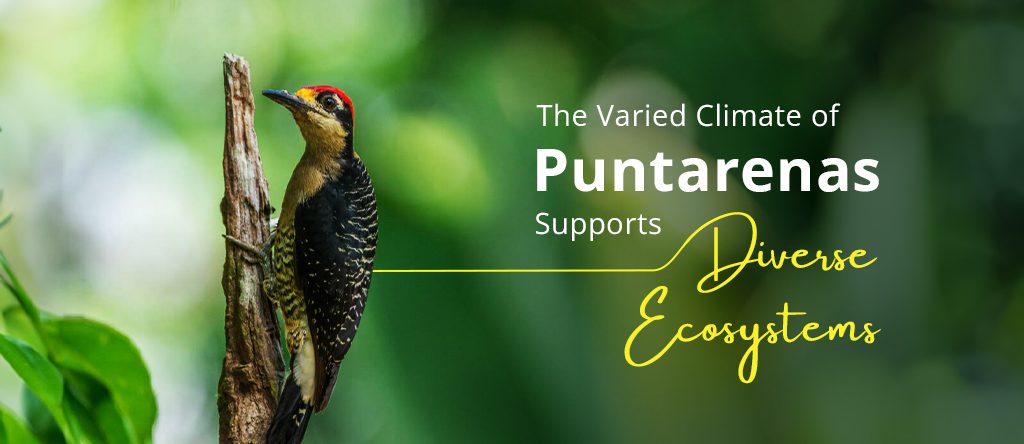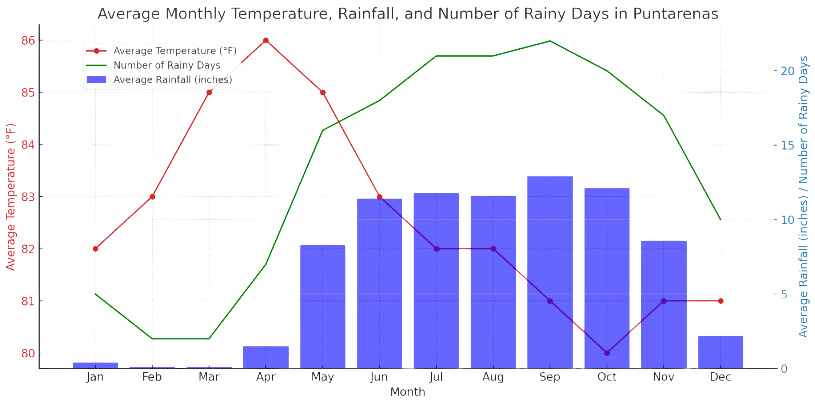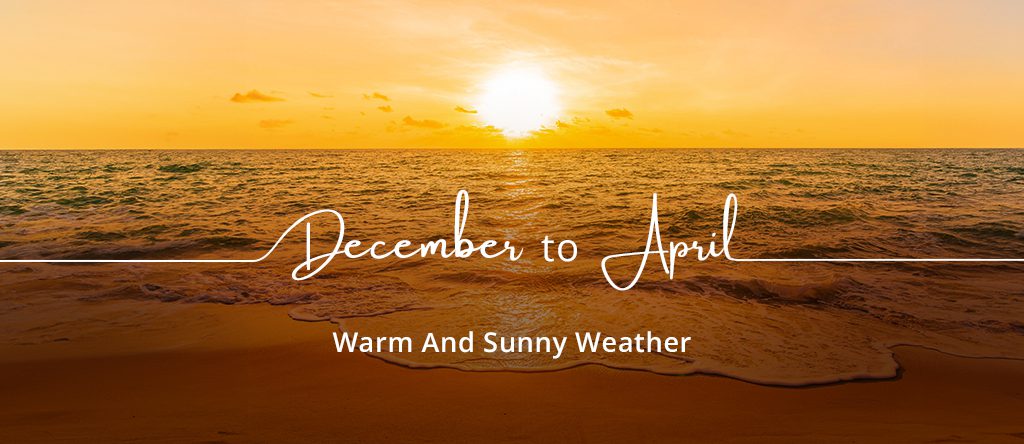Puntarenas is an enchanting province in Costa Rica with stunning scenery and diverse ecosystems. Tourists worldwide visit Puntarenas because of its magnificent coasts, dense rainforests, and lively fauna. The area’s cultural and ecological identity hinges on its peculiar climate and terrain.
If the amazing province of Puntarenas is also on your bucket list, you might need a guide to the geography and weather conditions there to plan your vacation.
Here is the tea about the geographical wonders, climate, and landscape of Puntarenas to help you plan everything.
Understanding the Climate of Puntarenas
Overview of Tropical Climate
Puntarenas has a tropical climate marked by warm temperatures and significant rainfall. This climatic condition supports a rich variety of flora and fauna, making Puntarenas a paradise for nature enthusiasts.
The General Characteristics of the Tropical Climate of Puntarenas
Puntarenas has a tropically average climate all year round. However, there might be slight variations in temperature and precipitation. It used to be very hot, with frequent rainfalls from May to September, and it is normally dry and hot from October to April.
Temperature Variations Throughout the Year
Average temperatures of Puntarenas are pretty uniform and vary from 75°F to 86°F. The warmest months in the region are March and April, and the coldest months are usually November and December.
On average, March is one of the warmest months throughout the year, with maximum temperatures varying at about 90°F. Moreover, the period favors many beach activities like swimming, sunbathing, surfing, etc., in contrast to November and December, which record a daily average temperature of about 73°F (23°C). Walking or visiting some places inland in these two months is more comfortable.

Rainfall and Weather Patterns
Indeed, in Puntarenas, precipitation is very heavy during the rainy season. The prediction is based on the different monthly precipitation averages; September and October are at the top.
September and October are the wettest months, with more than 10 inches (254 millimeters) of precipitation often observed in one month. Afternoon showers and thunderstorms are also common during these months.
February and March experience the least rainfall; the average rainfall is less than 2 inches (50 mm). Thus, engaging in any outdoor activity during these months is very convenient and enjoyable.
Table: Average Monthly Temperature and Rainfall in Puntarenas
This table and graph illustrate the average monthly temperatures, rainfall, and the number of rainy days in Puntarenas, providing a comprehensive overview of the region’s climate.
| Month | Average Temperature (°F) | Average Rainfall (inches) | Number of Rainy Days |
| Jan | 82 | 0.4 | 5 |
| Feb | 83 | 0.1 | 2 |
| Mar | 85 | 0.1 | 2 |
| Apr | 86 | 1.5 | 7 |
| May | 85 | 8.3 | 16 |
| Jun | 83 | 11.4 | 18 |
| Jul | 82 | 11.8 | 21 |
| Aug | 82 | 11.6 | 21 |
| Sep | 81 | 12.9 | 22 |
| Oct | 80 | 12.1 | 20 |
| Nov | 81 | 8.6 | 17 |
| Dec | 81 | 2.2 | 10 |
Graph: Average Monthly Temperature and Rainfall in Puntarenas

Average Humidity in Puntarenas
Humidity levels in Puntarenas are generally high, averaging around 80%. The wet season sees higher humidity, while the dry season offers slightly lower levels.
High humidity can create a sensation of warmth when it is not actually very hot. It is important to keep cool and rest in the shade as much as possible to avoid suffering from heat-related illnesses.
Wind Pattern in Puntarenas
The predominant wind patterns in Puntarenas are from the northeast, with an average speed of 8-24 kilometers per hour. These winds allow the region to cool off, which provides some relief from the heat.
Seasonal changes reverse the direction of the wind, but the wind is much stronger in the dry season. Such seasons may affect ocean currents, climatic conditions, sailing or fishing, or other marine activities.
Weather Influence on Local Ecosystems and Activities
The tropical climate of Puntarenas hosts many different types of ecosystems, ranging from coastal mangroves to inland rainforests. This habitat diversity contributes to many species of flora and fauna.
Endemic fauna in Puntarenas include scarlet macaws, capuchin monkeys, and several species of sea turtles. The plant life is colorful here, composed of hundreds-year-old giant ceiba trees, mangrove forests, and dense orchid packages.
Impact of Weather Change on Tourism and Outdoor Activities
The dry season between December and April is the premier mountain climbing and wildlife viewing period. Rainy season is suitable for both Surfing and white-water rafting.
In addition to that, Manuel Antonio National Park boasts rich biodiversity, while Monteverde Cloud Forest is renowned for rare climatic conditions and lush greenery that often attracts visitors.
Impact of Weather Change on Agriculture and Fishing
Climate is an integral part of agriculture and fishing for Puntarenas. The rainy season sustains coffee, bananas, and rice crops, but the dry season is the ideal time for fishing.
Tropical fruits, such as mangoes and pineapples, can be grown here, while the fishing industry thrives with catches of fish species like mahi-mahi, tuna, and shrimp.
Best Time to Visit Puntarenas
The ideal time to visit Puntarenas, Costa Rica, will vary depending on one’s personal weather preferences and interests in outdoor activities, as well as crowd tolerance. The tropical climate of Puntarenas has distinct wet and dry seasons, which provide diverse experiences for visitors all year round.
Let’s break it down in more detail:

Dry season: December to April
- Weather: This is when you find the most tourists in Puntarenas due to the sunny weather, regardless of the season you opted for. Some rain is experienced sparingly, with clear skies and warm temperatures, all happening under very low humidity.
- Activities: February is perfect for beach and snorkeling lovers. It is when Holidays and festivals, like Christmas or New Year, are celebrated. The carnival, abundant in flamboyant colors, also takes place there.
- Crowd Levels: It is the peak time to visit and is the most expensive. Book your tickets way ahead.
Green Season: May to November
The rainy season is called the green season in this part of the tropics. It brings daily showers and often culminates in thunderstorms every afternoon. The general pattern is heavy rainfall; however, it will usually be sunny and lovely in the mornings.
- Activities: The thick vegetation and vivid foliage create great scenery and the encounters of exotic tropical animals, as most of them are usually more active during that period. It is an excellent time to participate in outdoor activities before the rain sets in.
- Crowd Level: This makes the green season very attractive, as there are fewer crowds and lowered prices on accommodations and activities for people with a tight budget. However, local conditions should always be checked well in advance because certain roads and hiking trails may become impassable during heavy rains due to mudslides or floods.

Environment Conservation Efforts
Efforts to preserve Puntarenas’ natural habitats include reforestation projects and establishing protected areas. These initiatives help combat deforestation and encourage a boost in biodiversity.
Besides, Corcovado and Manuel Antonio national parks are keystones in maintaining conservation; they protect not only the habitats of wildlife species but also practice sustainable, regenerative, and ecotourism methods.
Locals adapt to climate variability through sustainable farming practices and the use of renewable energy sources. This helps to reduce the impacts of climatic changes while maintaining an ecological balance in the area.
Habitat conservation activities in Puntarenas aim to restore natural habitats. Locals adapt to climatic variability through sustainable agriculture and using naturally available energy sources. The method can help alleviate the effects of climate change and allow for an ecological balance to continue being maintained in the area. Daily wise practices include switching to solar power, recycling, and local-led attempts at conservation. Ecotourism initiatives focus on minimizing environmental impact while providing educational experiences for visitors.
Conclusion
Puntarenas is one of the most exciting provinces due to its unique climate and landscape. Its tropical weather, diverse ecosystems, and commitment to balancing nature and ecology create a refreshing mix of natural beauty and sustainable living. Visiting Puntarenas allows tourists to enjoy the unbeatable weather, rich biodiversity, and vibrant culture.











